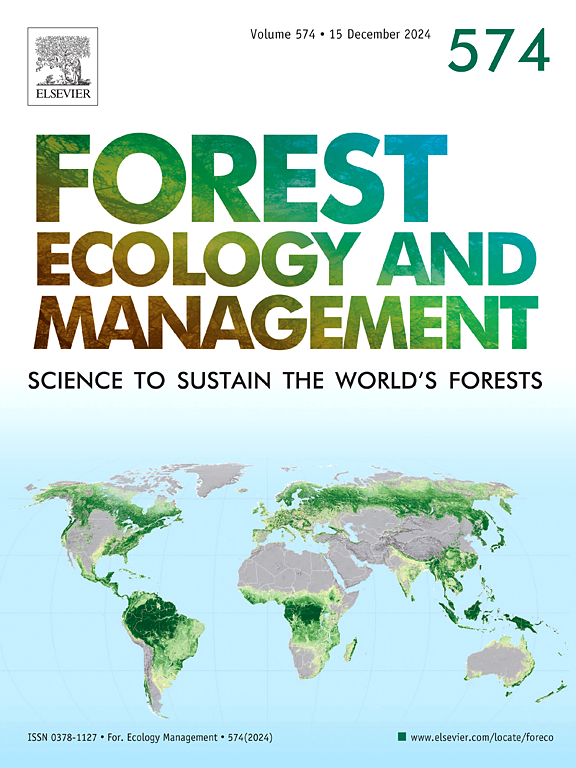Resilience and alternative successional trajectories in temperate forests exposed to two large herbivores
IF 3.7
2区 农林科学
Q1 FORESTRY
引用次数: 0
Abstract
Ungulate browsing is a key disturbance process influencing forest structure and composition, with the potential to alter forest resilience following canopy disturbance. We examined the effects of l5 years of white-tailed deer (Odocoileus virginianus) and moose (Alces alces americana) browsing in regenerating temperate forests of the northeastern U.S. We tested the alternative hypotheses that woody vegetation is (1) resilient to browsing, with structure and composition similar after stems have grown above the browser trap or (2) altered by browsing, resulting in long-term legacy effects. Three browser treatments—ungulate exclusion, deer, and deer + moose—were established in seven clear-cut stands. Basal area and species diversity did not differ significantly among treatments after 15 years, indicating resilience, whereas the abundance of two tree species was altered: pin cherry (Prunus pensylvanica) was lower by 3-fold in deer + moose plots, while white pine (Pinus strobus) was greater by over 5-fold. Forb cover was half as abundant in deer + moose plots compared to ungulate exclusion, while forb richness remained unaffected. Our results suggest that ungulate browsing during stand initiation can alter successional trajectories while still being compatible with long-term forest resilience; however, there are potential trade-offs between woody plant resilience and the vigor of the herbaceous layer when large herbivores are present. With relatively small long-term effects on structure and diversity and by accelerating succession towards longer-lived tree species, deer + moose browsing in northern temperate forests may be less of a management concern than is generally assumed.
暴露于两种大型食草动物的温带森林的恢复力和替代演替轨迹
有蹄类动物的取食是影响森林结构和组成的关键干扰过程,具有改变林冠干扰后森林恢复力的潜力。我们研究了美国东北部再生温带森林中15年白尾鹿(Odocoileus virginianus)和驼鹿(Alces Alces americana)浏览的影响。我们测试了木本植被(1)对浏览具有弹性,在茎长到浏览器陷阱以上后结构和组成相似,或(2)因浏览而改变,导致长期遗留效应的替代假设。在7个明确的林分中建立了三种浏览器处理-有蹄类排斥,鹿和鹿+ 驼鹿。15年后,不同处理间的基底面积和物种多样性差异不显著,显示了恢复力,但两种树种的丰度发生了变化:鹿+ 驼鹿样地的pin cherry (Prunus pensylvanica)丰度降低了3倍,而白松(Pinus strobus)丰度增加了5倍以上。与有蹄类动物排斥相比,鹿+ 驼鹿地的植被覆盖度是有蹄类动物的一半,而植被丰富度未受影响。研究结果表明,林分形成过程中有蹄类动物的取食可以改变演替轨迹,但仍与森林的长期恢复力相适应;然而,当存在大型食草动物时,木本植物的恢复力和草本层的活力之间存在潜在的权衡。由于对结构和多样性的长期影响相对较小,并通过加速向寿命较长的树种的演替,在北温带森林中觅食的鹿+ 驼鹿对管理的影响可能比通常认为的要小。
本文章由计算机程序翻译,如有差异,请以英文原文为准。
求助全文
约1分钟内获得全文
求助全文
来源期刊

Forest Ecology and Management
农林科学-林学
CiteScore
7.50
自引率
10.80%
发文量
665
审稿时长
39 days
期刊介绍:
Forest Ecology and Management publishes scientific articles linking forest ecology with forest management, focusing on the application of biological, ecological and social knowledge to the management and conservation of plantations and natural forests. The scope of the journal includes all forest ecosystems of the world.
A peer-review process ensures the quality and international interest of the manuscripts accepted for publication. The journal encourages communication between scientists in disparate fields who share a common interest in ecology and forest management, bridging the gap between research workers and forest managers.
We encourage submission of papers that will have the strongest interest and value to the Journal''s international readership. Some key features of papers with strong interest include:
1. Clear connections between the ecology and management of forests;
2. Novel ideas or approaches to important challenges in forest ecology and management;
3. Studies that address a population of interest beyond the scale of single research sites, Three key points in the design of forest experiments, Forest Ecology and Management 255 (2008) 2022-2023);
4. Review Articles on timely, important topics. Authors are welcome to contact one of the editors to discuss the suitability of a potential review manuscript.
The Journal encourages proposals for special issues examining important areas of forest ecology and management. Potential guest editors should contact any of the Editors to begin discussions about topics, potential papers, and other details.
 求助内容:
求助内容: 应助结果提醒方式:
应助结果提醒方式:


